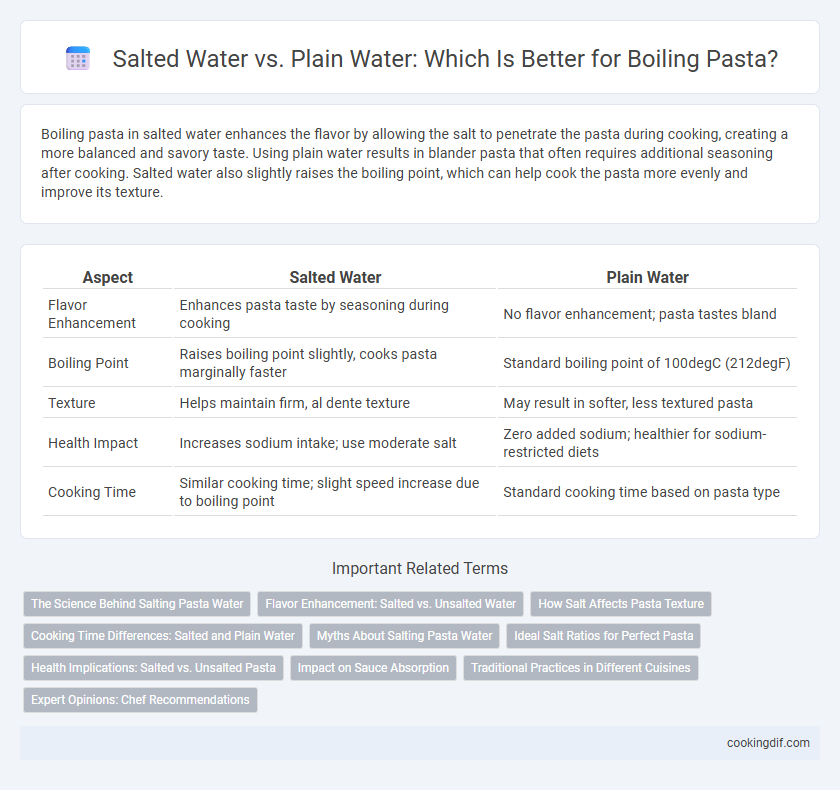Boiling pasta in salted water enhances the flavor by allowing the salt to penetrate the pasta during cooking, creating a more balanced and savory taste. Using plain water results in blander pasta that often requires additional seasoning after cooking. Salted water also slightly raises the boiling point, which can help cook the pasta more evenly and improve its texture.
Table of Comparison
| Aspect | Salted Water | Plain Water |
|---|---|---|
| Flavor Enhancement | Enhances pasta taste by seasoning during cooking | No flavor enhancement; pasta tastes bland |
| Boiling Point | Raises boiling point slightly, cooks pasta marginally faster | Standard boiling point of 100degC (212degF) |
| Texture | Helps maintain firm, al dente texture | May result in softer, less textured pasta |
| Health Impact | Increases sodium intake; use moderate salt | Zero added sodium; healthier for sodium-restricted diets |
| Cooking Time | Similar cooking time; slight speed increase due to boiling point | Standard cooking time based on pasta type |
The Science Behind Salting Pasta Water
Salting pasta water increases the water's boiling point slightly, which helps cook pasta more evenly and enhances texture by reducing stickiness. Salt also penetrates the pasta surface, seasoning it internally and improving flavor absorption. The presence of sodium ions strengthens gluten networks, resulting in a firmer and more resilient pasta bite.
Flavor Enhancement: Salted vs. Unsalted Water
Boiling pasta in salted water significantly enhances the flavor by allowing the pasta to absorb enough sodium, which acts as a seasoning during cooking. Unsalted water results in bland pasta that requires more seasoning later, often leading to uneven distribution of salt in the final dish. Sea salt or kosher salt in boiling water elevates the overall taste profile, ensuring the pasta itself contributes to the dish's seasoning depth.
How Salt Affects Pasta Texture
Salted water raises the boiling point, allowing pasta to cook more evenly and enhancing its firmness by strengthening the starch structure. The sodium ions from salt interact with gluten proteins, reducing stickiness and promoting a chewy, al dente texture. Boiling pasta in plain water often results in a softer, less flavorful dish due to insufficient protein interaction and seasoning absorption.
Cooking Time Differences: Salted and Plain Water
Salted water raises the boiling point, allowing pasta to cook slightly faster compared to plain water, where the boiling point remains at 100degC (212degF). The difference in cooking time is generally minimal but can enhance the pasta's texture and flavor when boiled in salted water. Using plain water may require an extra minute or two for the pasta to reach the desired al dente consistency.
Myths About Salting Pasta Water
Salting pasta water enhances flavor and raises the boiling point slightly, but it does not significantly speed up cooking as commonly believed. The myth that salted water takes longer to boil stems from the small amount of salt used, which has minimal effect on boiling time. Properly salted water ensures the pasta absorbs seasoning evenly, improving taste without altering texture or cooking duration.
Ideal Salt Ratios for Perfect Pasta
Boiling pasta in salted water enhances flavor and helps season the pasta evenly from the inside out. The ideal salt ratio is approximately 1 to 1.5 tablespoons of kosher salt per 4 quarts (16 cups) of water, which mimics the salinity of seawater and brings out the pasta's natural taste. Using plain water results in bland pasta that lacks depth, making salted water essential for achieving perfectly seasoned pasta.
Health Implications: Salted vs. Unsalted Pasta
Boiling pasta in salted water enhances flavor without significantly increasing sodium intake, as most salt remains in the water after draining. Cooking pasta in plain water reduces sodium content but may result in blander taste, potentially leading to added salt or high-sodium sauces later. Choosing salted or unsalted water affects overall dietary sodium, which plays a crucial role in managing blood pressure and cardiovascular health.
Impact on Sauce Absorption
Boiling pasta in salted water enhances the surface texture of the noodles, allowing them to better absorb sauces. Salted water causes the pasta to maintain a firmer exterior, which helps it cling to sauce particles more effectively than pasta boiled in plain water. This improved sauce absorption maximizes flavor integration in dishes like spaghetti Bolognese or fettuccine Alfredo.
Traditional Practices in Different Cuisines
Traditional Italian cuisine emphasizes boiling pasta in generously salted water to enhance flavor and prevent sticking, reflecting a long-standing culinary practice. In contrast, some Asian cuisines often use plain water for boiling noodles, relying on sauces and broths to impart seasoning post-cooking. These diverse methods highlight regional preferences and the role of salt in pasta texture and taste development.
Expert Opinions: Chef Recommendations
Chefs recommend boiling pasta in salted water because it enhances the flavor by allowing the pasta to absorb seasoning as it cooks. Salted water raises the boiling point slightly, which can lead to more evenly cooked pasta with improved texture. Using plain water often results in bland-tasting pasta that requires extra seasoning after cooking.
Salted water vs plain water for boiling Infographic

 cookingdif.com
cookingdif.com